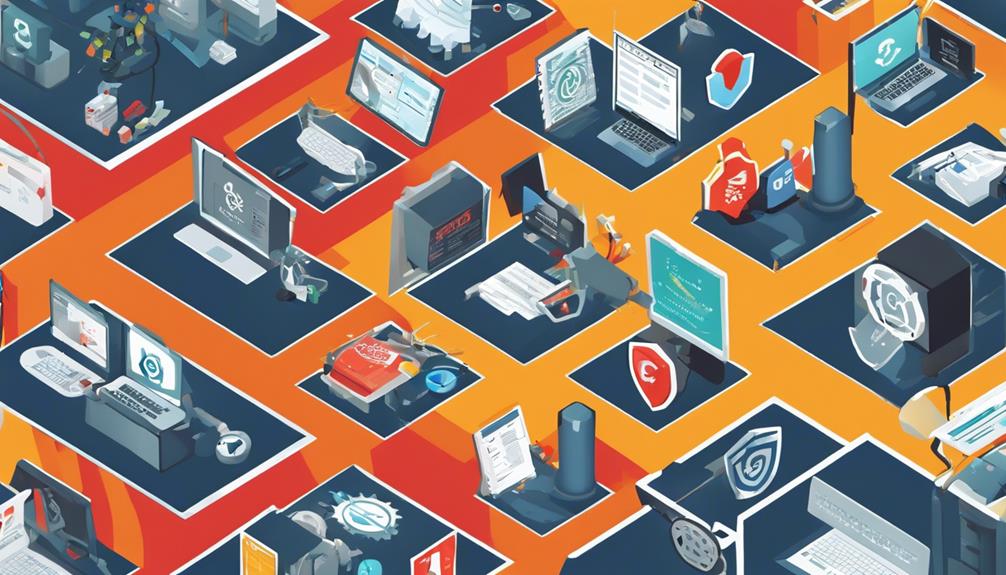Ethical hacking is an essential part of cybersecurity, using authorized methods to evaluate and enhance system, network, and application security. Key concepts include Reconnaissance, Scanning, Gaining access, Maintaining access, and Clearing tracks. Various hacker types like White Hat, Black Hat, and Grey Hat exist, each with distinct motives. Ethical hacking phases include Reconnaissance, Scanning, Gaining access, Maintaining access, and Clearing tracks. Certifications such as CEH and CPENT assess security vulnerabilities, with high industry demand. Ethical hackers need skills in programming, networking, and continuous learning to tackle evolving threats. Understanding ethical hacking essentials reveals its critical role in safeguarding digital assets.
Key Takeaways
- Ethical hacking involves phases like reconnaissance, scanning, gaining access, maintaining access, and clearing tracks.
- Different types of hackers include White Hat, Black Hat, Grey Hat, Red Hat, and Blue Hat hackers.
- VAPT certifications like CEH and CPENT validate skills, meet industry demand, offer real-world testing, and create career opportunities.
- Essential skills for ethical hackers include programming, networking, and continuous learning to combat security threats effectively.
- Ethical hacking is a comprehensive process that focuses on improving security, preventing cyber attacks, and testing vulnerabilities.
Core Concepts of Ethical Hacking
The core concepts of ethical hacking form the foundation for systematically evaluating and securing digital systems and networks. Ethical hacking involves authorized practices aimed at identifying and exploiting vulnerabilities in systems to enhance cybersecurity.
These core concepts include:
- Reconnaissance involves gathering information about the target system or network.
- Scanning is the process of identifying open ports and services.
- Gaining access refers to the phase where the ethical hacker attempts to penetrate the system.
- Maintaining access to guarantee persistent control.
- Clearing tracks involves removing any evidence of the ethical hacker's presence to uphold stealth.
Understanding and addressing these core concepts are essential for ethical hackers to effectively identify weaknesses, prevent unauthorized access, and protect sensitive data from cyber attacks, ultimately contributing to improving overall cybersecurity.
Types of Hackers and Hacking

Different categories of hackers exist in the domain of cybersecurity, each with distinct motives and approaches towards hacking. White Hat hackers, also known as ethical hackers or cybersecurity professionals, focus on improving security and preventing cyber attacks.
On the other hand, Black Hat hackers are cybercriminals who exploit vulnerabilities for malicious purposes. Grey Hats fall in between, with mixed motivations engaging in both ethical and unethical hacking activities.
Red Hat hackers are aggressive hackers who work to stop cybercriminals and protect systems, while Blue Hat hackers are hired by tech companies to test the security of their products. These different types of hackers play important roles in the field of information security.
Ethical hackers, also known as penetration testers, carry out penetration testing to identify vulnerabilities and strengthen security measures. Understanding the distinctions between these various hacker types is essential for comprehending the dynamics of security and ethical hacking.
Phases of Ethical Hacking

Understanding the operational phases of ethical hacking provides a structured approach for cybersecurity professionals to systematically assess and fortify the security posture of systems and networks.
The phases include:
- Reconnaissance: Hackers gather information about the target system.
- Scanning: Probing for vulnerabilities and weaknesses.
- Gaining access: Exploiting vulnerabilities to enter the system.
- Maintaining access: Ensuring continued control over the system.
- Clearing tracks: Covering up evidence of the intrusion to evade detection.
These phases are essential for ethical hackers to identify potential exploits, understand system weaknesses, and enhance overall security.
VAPT Certifications Overview

Exploring the domain of VAPT certifications offers cybersecurity professionals a gateway to honing their vulnerability assessment and penetration testing skills. Here are some key points to ponder about VAPT certifications:
- Validation of Skills: Certifications like CEH and CPENT focus on evaluating and exploiting security vulnerabilities, validating expertise in this vital aspect of cybersecurity.
- Industry Demand: VAPT certifications are highly sought after in the cybersecurity industry for showcasing practical, hands-on hacking skills that are essential for securing systems and networks.
- Real-World Testing: Advanced certifications like CEH (Practical) and LPT (Master) go beyond theory, testing professionals on their ability to conduct real-world penetration testing effectively.
- Career Opportunities: Holding VAPT certifications can open doors to lucrative career opportunities in ethical hacking and cybersecurity, as organizations increasingly prioritize robust security measures to protect their digital assets.
Skills for Ethical Hackers

Proficient ethical hackers possess a diverse set of technical skills essential for identifying and addressing cybersecurity vulnerabilities effectively. These skills range from programming and scripting for application and network security to understanding databases, hacking tools, search engines, and servers. Networking skills are important for recognizing threats and compromised devices, while continuous learning is essential to keep up with evolving security risks. An in-depth comprehension of systems, networks, program codes, and security measures is key for ethical hackers to succeed in their roles.
| Skills | Description | Importance |
|---|---|---|
| Programming | Essential for application and network security | High |
| Networking | Critical for identifying threats and compromised devices | High |
| Continuous Learning | Necessary to stay updated on evolving security threats | High |
These essential skills equip ethical hackers to effectively utilize techniques and tools in line with Certified Defense (DoD) Directive for Web Application security and beyond.
Frequently Asked Questions
What Are the 5 Stages of Ethical Hacking?
The 5 stages of ethical hacking involve reconnaissance, scanning, gaining access, maintaining access, and clearing tracks. This process includes information gathering, vulnerability identification, exploitation, persistence in access, and covering tracks to guarantee ethical boundaries are upheld.
What Are the Basics to Learn Ethical Hacking?
To grasp the fundamentals of ethical hacking, focus on understanding hacking principles, techniques like reconnaissance and gaining access, tools such as Nmap and Metasploit, and practical experience through labs and online platforms. Keep abreast of cybersecurity trends for proficiency.
What Is Ethical Hacker Salary?
Ethical hacker salaries vary by region and experience level. In the U.S., the average is $90,000 annually, while in India, earnings can include bonuses of INR 5,000 to INR 2 lakh, with potential for Certified Ethical Hackers to earn up to INR 5.11 lakh.
What Is Ethical Hacking Pdf?
Discover the secrets of ethical hacking with detailed PDF resources. These materials explore penetration testing, vulnerability assessment, and network security, offering guides, tutorials, and practical exercises to enhance cybersecurity knowledge and skills.
Conclusion
To wrap up, ethical hacking plays a crucial role in the world of cybersecurity, allowing organizations to identify and address vulnerabilities before they are exploited by malicious actors.
By understanding the core concepts, types of hackers, phases of ethical hacking, VAPT certifications, and necessary skills, individuals can become proficient in this important field.
Like a digital detective, ethical hackers work behind the scenes to protect data and secure systems from potential threats.









